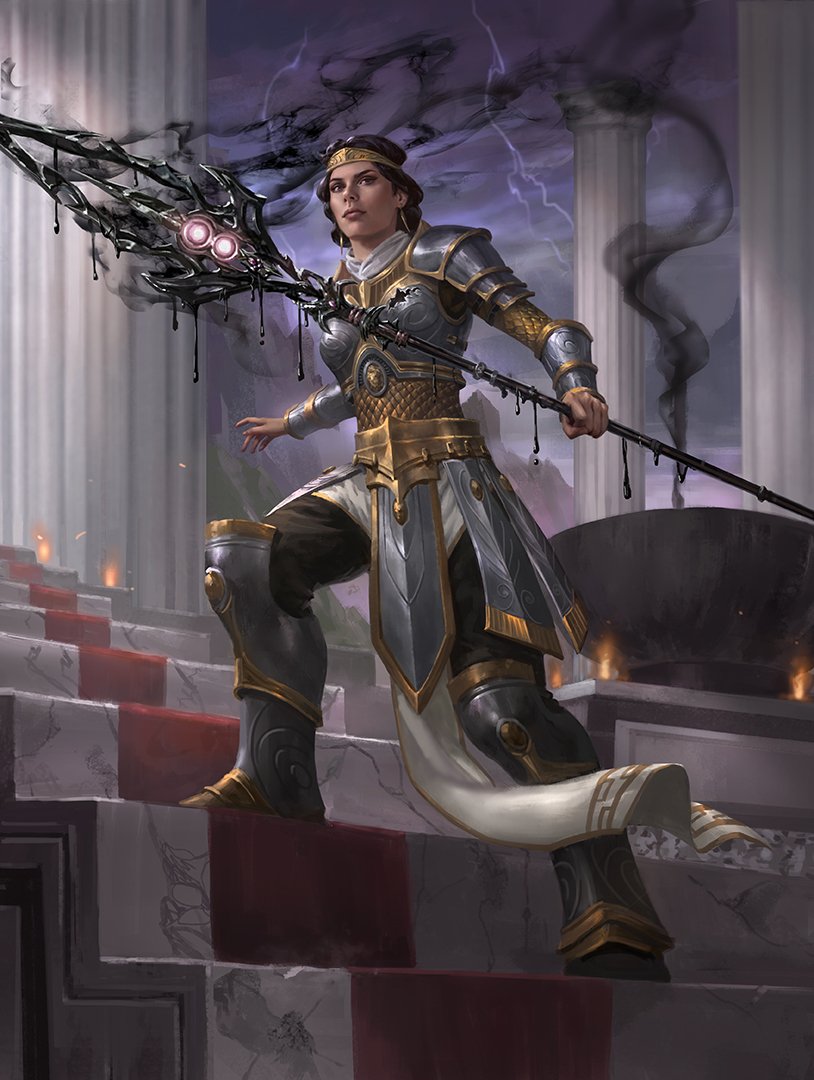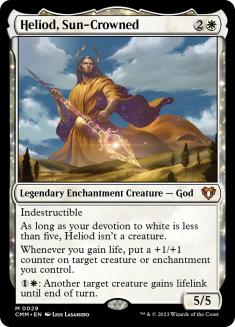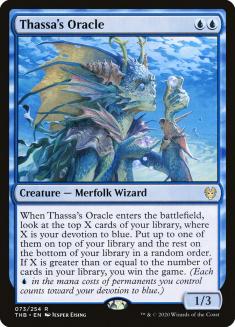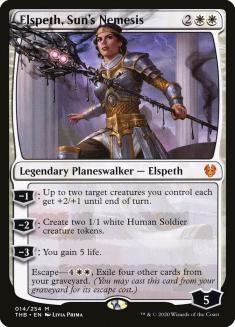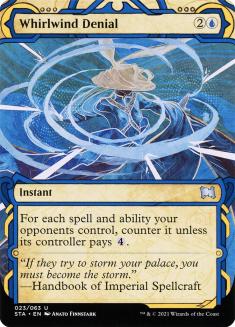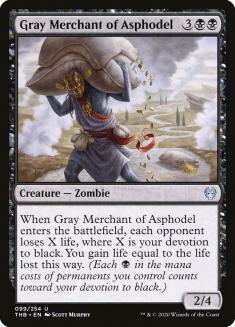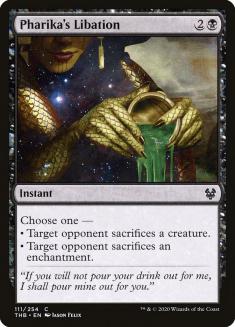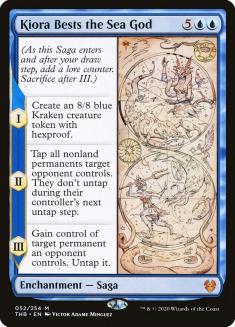Magic is an ever-changing game, and each new set brings new cards to evaluate. Invariably, the community falls in love with future bulk rares and overlooks future staples. Today, I’m going to highlight several Theros Beyond Death cards that are being substantially misevaluated. Note that I am assessing each card relative to popular perception, not in an absolute sense.
Overrated: Heliod, Sun-Crowned
When Heliod, Sun-Crowned was previewed, the Magic community was terrified. Two-card combos that win the game on their own have historically been excellent, and Heliod and Walking Ballista are both reasonable cards on their own. Many called for a ban in Pioneer without playing a single game with the card.
The problem with this combo is several-fold. First, it costs nine mana total, and typically does not become active before Turn 5. That means that it is not fast enough to race combo decks like Lotus Field and Underworld Breach in Pioneer. Splinter Twin and similar combo decks could fall back on their combo to steal games against the nonsense decks that are popular in eternal formats. Heliod + Ballista is too slow to have this sort of advantage.
Second, it’s vulnerable to the cheapest of spot removal. Part of why Splinter Twin and Copy Cat were so strong is that the four-toughness bodies involved (Deceiver Exarch, Felidar Guardian) dodged most popular spot removal. But Walking Ballista dies to even one-mana spells like Fatal Push and Wild Slash, which happen to be the two best removal spells legal in Pioneer overall. It doesn’t help that Heliod’s demand for devotion means that shells planning to utilize the body must run other cards vulnerable to removal. This means that opponents can load up on spot removal with impunity. The fact that both cards are individually solid means that against fairer decks it will still be fine, but I think it is important to recognize the lack of random nonsense protection.
This is a fairly hot take, so let me clarify before anyone burns their tongue: I am not saying that Heliod will see no play. I expect it to be part of a Tier 1 deck in both Standard and Pioneer. That said, I think it is unlikely that either half of the combo will be banned in any format and I’m not convinced it is even the best deck in Pioneer.
Underrated: Thassa’s Oracle
To illustrate why I think Thassa’s Oracle is amazing, let me share a story. A few years ago, I was watching a match of Modern featuring Eldrazi Tron against Ad Nauseam. The Ad Nauseam player went for an end-step Echoing Truth on Chalice of the Void, and then untapped and cast Angel’s Grace and Ad Nauseam. But after drawing their deck, they realized something very strange had happened. The Eldrazi Tron player controlled a pair of Endbringers and a Spellskite. The Spellskite could redirect any lethal Lightning Storm enough times to run the Ad Nauseam player out of lands. and the Endbringers would kill any Laboratory Maniac. The Ad Nauseam player was unable to win after drawing every card in their library and was forced to concede.
The moral of this story is that Ad Nauseam is a terrible deck combo win conditions matter. Playing blank cards that only enable the win is awful, and having those cards be vulnerable to spot removal is even worse. Thassa’s Oracle means that any combo based around having an empty library has access to a card that wins the game whenever it goes off, so long as it enters the battlefield. Additionally, if you end up needing to cast it for some reason, it actually does a reasonable job of blocking and digging towards combo pieces. In Legacy, this card is revitalizing the Cephalid Breakfast archetype. In Pioneer, it is the preferred kill condition of Underworld Breach combo decks (covered yesterday by Todd Anderson). This card will be the preferred win condition of combo decks for years to come.
In addition to its incredible potential in combo decks, I expect Thassa’s Oracle to be a Mono-Blue Devotion role-player in both Standard and Pioneer. This is partially because there isn’t a lot of competition for cards with a mana cost of exactly UU and partially because devotion decks tend to vary wildly in card quality, so card selection is particularly useful.
Overrated: Elspeth, Sun’s Nemesis
There was a time in Magic’s history when answers were better than threats. In those days, resiliency and recurring advantage were the name of the game and mana efficiency was a secondary concern. If Elspeth, Sun’s Nemesis had been printed during that era, it would rapidly have earned a ban in every format. But Magic isn’t that game anymore. These days, there are many cards that generate value every turn they stay on the battlefield, or simply by entering it. The concept of card advantage has changed. How many cards is a resolved Nissa, Who Shakes the World worth? Five? Eight? More?
These days, the rate of impact for mana cost matters a lot because sources of card advantage are everywhere. Elspeth, Sun’s Nemesis has underpowered abilities for its mana cost and purports to make up for it by being recursive. However, every time you invest mana into Elspeth she is inefficient, so the fact that you can do it repeatedly is still not that impressive. A couple of Soldier tokens and some life points are not worth four mana, much less six. Every time a player casts this card, they are giving up mana efficiency, and that is not acceptable.
Underrated: Whirlwind Denial
Whirlwind Denial is underrated primarily because nobody has really noticed it exists. Whirlwind Denial is Modern’s Flusterstorm, able to counter 100 Grapeshots. It costs more, but it is also substantially more versatile. Whirlwind Denial can stop a lethal Scapeshift by simply countering all the Valakut triggers. It can counter an Ulamog, the Ceaseless Hunger and the cast trigger in one fell swoop. If your Amulet Titan opponent uses Cavern of Souls to cast an uncounterable Primeval Titan, Whirlwind Denial can stop the trigger, so you can cleanly answer the Titan with a single additional removal spell. Against Dredge, it can stop large numbers of Narcomeoba and Creeping Chill triggers all at once.
At three mana, I don’t think Whirlwind Denial is going to see maindeck play anytime soon. But in the sideboard of blue control decks, this card covers a surprisingly large amount of the metagame. If your opponent is doing anything unfair, Whirlwind Denial is probably good against it.
Overrated: Gray Merchant of Asphodel
The last time Mono-Black Devotion was in Standard, it was the best deck in the format. Gray Merchant of Asphodel did happen to be in that deck, but it was a figurehead. The power behind the throne was Thoughtseize, Mutavault and Hero’s Downfall.
When your opponent’s core threats are answered and their synergies are disrupted, it is easy to answer whatever is left with a defensive body and a giant Drain Life. But without that disruption, this card is not going to trump the late-game of almost anything. Moreover, Standard at present does not have devotion enablers on the power level of Nightveil Specter, Lifebane Zombie, or even Underworld Connections. Yarok’s Fenlurker was a medium Limited card and I have no interest in putting it into my Constructed deck.
There is a certain segment of the Magic community that tries to make Mono-Black Control work in every Standard format. I regret to inform that segment that this is not the time for it.
Underrated: Pharika’s Libation
I get that the rate on Pharika’s Libation is atrocious, but hear me out. Right now, Mono-Black Aggro is a Tier 1 archetype in Pioneer. In addition, two of the premier combo decks in the format rely heavily on enchantments. Pharika’s Libation answers Heliod and is good against Underworld Breach, even if you sometimes hit Chronic Flooding (removing their self-mill element is decent, although not game-ending).
All-in-all, I think the ability to answer resolved enchantments in black has the potential to see play in Pioneer sideboards. It may just be worse than additional discard spells, though. I am not certain.
Overrated: Kiora Bests the Sea God
There have been times in Magic’s history where Kiora Bests the Sea God would have been a Standard staple. It has a powerful effect that is difficult to interact with and breaks any midrange ground stall wide open. Unfortunately, right now is a really bad time to be playing this effect. The first issue with the card is that Shatter the Sky appears in the same set. Five-mana sweepers typically see restricted play, even in nearly creatureless control decks. Four-mana sweepers, on the other hand, are typically heavily played in every control deck of the relevant colors and sometimes justify playing those colors in the first place. If every control deck has four copies of Shatter the Sky, the hexproof Kraken token starts to look a lot less appealing.
The other problem with Kiora Bests the Sea God is simple: Finale of Devastation exists. On most battlefields where the Saga would perform, a Finale for End-Raze Forerunners would end the game on the spot. This does cost more mana, but I think that is not incredibly important in the sorts of games where these effects are strong. Additionally, Nissa makes seven mana look really similar to ten. In exchange for costing more, Finale offers far more versatility, serving as a decent curve filler at any point on the curve thereby also making it less awkward to draw in multiples. In a tight spot, Finale can also find useful bullets, whereas Kiora Bests the Sea God always just makes an 8/8.
That’s enough telling people on the internet they are wrong for one day. Evaluating new cards is incredibly difficult for even the best in the game, so please cut me some slack. I am reasonably confident about most of my assessments here, but will inevitably be wrong about something. When I am, feel free to give me the harshest punishment the internet can offer: merciless Twitter taunting.

